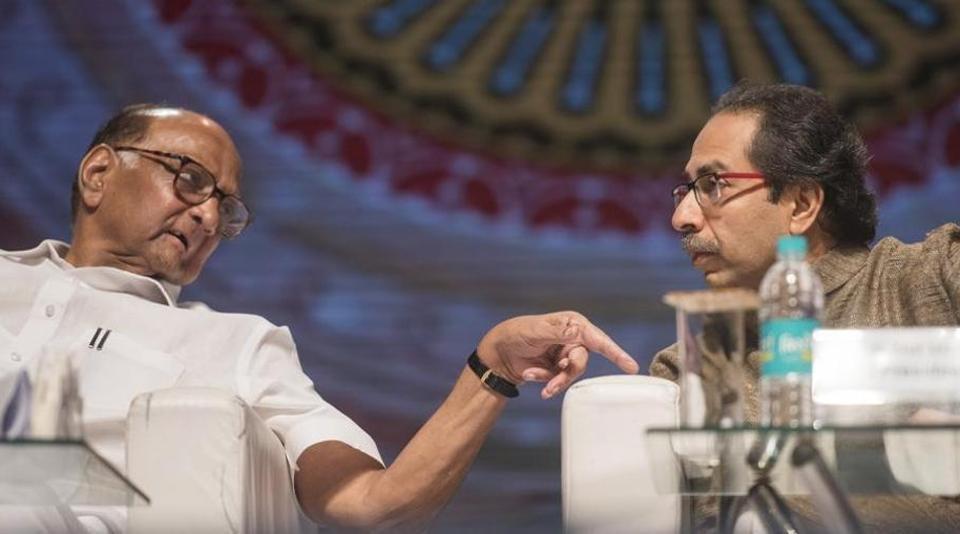After a series of deliberations and negotiations in New Delhi and Mumbai between the Shiv Sena, Nationalist Congress Party (NCP) and Congress, the three players in this protracted drama seem to have reached some consensus.

Four weeks after the 2019 Maharashtra Assembly election results were announced on October 24 the state is likely to get a government in the fifth. After a series of deliberations and negotiations in New Delhi and Mumbai between the Shiv Sena, Nationalist Congress Party (NCP) and Congress, the three players in this protracted drama seem to have reached some consensus.
A crucial meeting of the three parties on Friday suggested that there is consensus that Shiv Sena chief Uddhav Thackeray should be the next chief minister of Maharashtra. NCP chief Sharad Pawar said, “There is a consensus that leadership of the government will be with Uddhav Thackeray.” Interestingly, Thackeray did not confirm this, and said “All will be clear on Saturday.”
Thackeray’s late night meeting on Thursday with Pawar meant that they had hammered out at least a working agreement, if not a final formula. That formula was finalised a day later. Earlier on Thursday, the Congress Working Committee gave its formal approval for its support to a coalition government. Since Governor Bhagat Singh Koshyari has cancelled his scheduled visit to New Delhi on Saturday, it is evident that he is waiting for the three parties to stake claim today.
To be sure, an alliance between the Shiv Sena, the Congress and the NCP is easily one of the most unusual in recent Indian political history; it is a Coalition of the Improbables, one could say. It is obvious that they have managed to stitch this together on the Kautilyan philosophy of “My enemy’s enemy is my friend”; that is, all three have a common goal – to keep the Bharatiya Janata Party (BJP) out of power.
The working agreement between the three will be what is being called a Common Minimum Programme (CMP), and it will include a broad range of issues that the alliance is likely to agree upon during the period it governs, including the post of chief minister and the sharing of six key departments – home, finance, urban development, revenue, public works, and housing.
The real question is this, though: does this combination have the political stamina or the will for ideological adaptation to last a full five-year term? Maharashtra hope they do, but the answer is probably no.
The Congress and the Sena have been bitter political adversaries in the state for decades, and though the latter’s founder Bal Thackeray had welcomed former Prime Minister Indira Gandhi’s imposition of Emergency in 1975, there is no love lost between the two, especially over the Mumbai party’s hardline Hindutva ideology. In fact, it was this difference that delayed a decision by the Congress’ acting president Sonia Gandhi earlier in early November to agree to a coalition. This delay eventually cost the Sena a chance to form the government in the first instance and it faced an embarrassing situation on November 10 when Yuva Sena chief Aaditya Thackeray went to the Governor’s official residence to stake claim, but had to return empty-handed, with no extension to the Governor’s deadline.
Over the years, the Shiv Sena has consistently attacked the Congress over what it calls the party’s Muslim appeasement policies, its alleged involvement in corruption scandals and even Mrs Gandhi’s foreign origin. In January 2012, for instance, the senior Thackeray had said in an interview to party mouthpiece Saamana, “What love will she (Sonia Gandhi) have for this country? What is her contribution here?” He added, “Congress has polluted the atmosphere in the country.”
In the run-up to the 2019 Lok Sabha elections, the Sena, much like its then alliance partner BJP, had taken on the then Congress president Rahul Gandhi.
Contemporaneously, after the Supreme Court’s verdict in the Ayodhya matter, the two parties may be at loggerheads with each other in the manner in which the issue is resolved. Notably, the Congress welcomed the Ayodhya verdict on November 9, but its minority voter base may not exactly be on the same page, given the Sena’s alleged role in the December 1992 riots in Mumbai that followed the demolition of the Babri Masjid in Ayodhya on December 6. The riots that lasted six days between December 7 and December 12 resulted in the deaths of at least 700 people. Bal Thackeray was arrested in July 2000 for his alleged complicity in inciting them. It was the Congress-NCP government that had sanctioned his arrest under Section 153A of the Indian Penal Code (the case was later dismissed). It was for the first time in Shiv Sena’s chequered history that a Congress-led government had acted against him.
Though this seems like the distant past, this seeming ‘insult’ could become a bone of contention whenever a disagreement arises between the two during their time in power, even though the Congress-NCP government gave Thackeray a state funeral in November 2012 and later reserved land for his memorial.
The other twist in the tale is the NCP itself. Though its spokespersons have repeatedly said the party will try its best to support an alliance with the Sena and Congress, five years ago, in October 2014, soon after the Maharashtra elections, the NCP unilaterally decided support the Bharatiya Janata Party (BJP). Sena may fear the same in 2019. Pawar, after all, can spring a surprise any time (the BJP with 105 seats and the NCP with 54 can, theoretically, come together as the majority mark in the 288-member Assembly is 145). It is this suspicion that is likely to create a trust deficit between the three parties.
The coalition, therefore, may be ready to form a government and will reach out to the Governor, but the alliance partners may not have a long-term common ground to stand on, despite the CMP. It is for this reason that the first few months of the new government will be key to gauge what the next five years are going to look like in Maharashtra.
